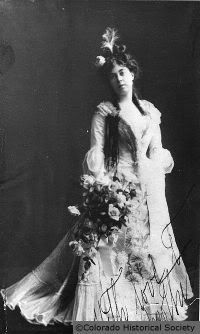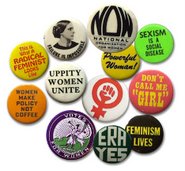History Corner or Women I'd Like to Meet
Ever play that game where you try to come up with five or ten people, dead or alive, that you would want to meet? I'm really bad at that game. No matter what the numerical limit is, I can never stay under it. There's always just one more fascinating person I would want to have coffee with. Well, add another one to the list.
Margaret Brown.
You know, "Molly" Brown, The Unsinkable Molly Brown.

Last week I rented A Night To Remember. It's a British film made back in 1958 about the sinking of the Titanic. I totally recommend picking this up if you have the inclination. It was a great flick. You can play a rousing game of "What did James Cameron Steal From This Movie" if you have a pen and paper and an ounce of sense. Great fun. But, I digress. As with any story about the doomed Titanic, Margaret Brown figures in as a colorful, outspoken, brassy gal traveling in first class. Kathy Bates played her in the most recent version, Tucker McGuire played her in A Night To Remember. She has always been one of my favorite parts of the tale. At a time when most women were forced into very confined roles and given very little power over our own lives (we were still eight years away from the right to vote in 1912) she seemed like a woman who didn't suffer this sort of nonsense.
But aside from talking back to sailors in life boats and being generally outspoken, what did she really do? Who was she? I did a little reading this week and I gotta say, Margaret Brown was an amazing woman.
She was born into a poor, working class, Irish family. Her parents emigrated to the U.S. during the Irish potato famine like so very many others. The family of seven lived together in a one bedroom house in Hannibal, Missouri. She worked in a tobacco factory as a child to help earn money for the family after attending school until the ripe old age of 12.
She moved to Leadville, Colorado with her brother and later met John James Brown, an engineer for one of the local gold mining companies. They fell in love and got married even though Margaret had planned on finding herself a rich man to marry. I guess she figured love was a more important consideration for life-long commitment than a large bank account despite her childhood experiences with extreme poverty and child labor. As it turned out, J.J. invented a method of preventing cave-ins at The Little Johnny Mine and was rewarded by his employers with a share of the gold mine. Nice little bonus, huh?
So, now that Maggie was a wealthy gal, what was she to do with her new found position in society? Lounge around the big house and eat bon-bons? Hells no! She put her good fortune (literally!) to use helping people who didn't happen to marry successful gold mine engineers. Check out some of the stuff she did:
* She put her money to use first in getting herself a little more education. She learned to speakFrench, German, Italian, Spanish and Russian with the help of tutors.
* She became a travel writer for the Denver Times newspaper, and wrote of her adventures, such as crossing the Alps in a Mercedes limousine. (Do they have roads across the Alps suitable for a limo?)
* She was one of the first women to attend the Carnegie Institute. Molly studied acting in the style of Sarah Bernhardt.
* While in Switzerland, she hired a master yodeler, and became adept at yodeling.
* For the Catholic Church, Molly organized a "Carnival of Nations," in 1906 based on the St. Louis World's Fair she had attended in 1904. Being the progressive person she was, she included booths not only for the mainstream European nationalities, but also for the African -Americans, the Chinese-Americans, and the Native-Americans.
* She also became friends with Denver's Judge Ben Lindsey who organized the nation's first juvenile court system, (which helped form the basis of the modern U.S. juvenile courts system)for which Molly raised funds by donating the proceeds of a Cripple Creek mining operation.
* She became a suffragette and attended national rallies on women's rights in places like Newport, Rhode Island, where the Browns rented a summer house.
* She was on the picket lines with the United Mine Workers, and the United Garment Workers, fighting for improved labor conditions. After the Ludlow Massacre in Colorado, she was there with Mother Jones aiding the relief work for the victims of that strike.
* In 1909 and 1914, she ran for Congress
Titanic Stuff:
We know from the transcripts of the hearings that took place in New York and England after the sinking that Mrs. Brown had words with the officer in charge of her life boat. He was convinced that they were all goners and that the Titanic would simply suck them all to the bottom of the sea when it went down. What were they teaching these guys back in the day? Anyway, she wasn't having any of it and she organized the ladies in the boat to keep rowing in order to stay warm. Then, once they were all aboard The Carpathia, she began putting together a fund for the victims of the disaster who would be left completely broke. Now really, who starts organizing a relief committee after a night spent bobbing around on the freezing cold North Atlantic after watching the largest ship in the world sink to the bottom of the ocean with most of the steerage passengers still aboard?
When the RMS Carpathia arrived to rescue the survivors, Margaret assisted with the rescue efforts; her proficiency in languages was an asset, she helped prepare survivor lists for outside communication and raised funds with other rich survivors to help those less fortunate among surviving passengers and crew, collecting $10,000 by the time the ship made port in New York City. For her calm action in the disaster, the media acclaimed her as one of the heroines of the hour. She was quoted as saying that her survival was attributable to "typical Brown luck... we're unsinkable". She became known as the Unsinkable Mrs. Brown for the rest of her life.
She went on to head the Titanic Survivors' Committee, participated in
fundraising for victims of the sinking and helped to get a memorial to the Titanic erected in Washington, D.C.
I think my favorite thing is that she ran for Congress years before women could even vote in The United States. That just rocks. With her concern for less fortunate, working class folks and her ability to get things done, she'd have been a great congreswoman. I would have voted for her...if I had been allowed to vote.
So, I now have to add Mrs. Margaret Brown to my list of people (dead or alive) that I would want to have a long talk with over tea and biscuits. I mean, c'mon, checkout the look she is giving the photographer here...
That's a woman with opinions and a story or two to tell.





4 comments:
Rock On! Don't forget their is a broadway musical called, "The Unsinkable Molly Brown" as well.
oops! Wrong there. I swear, I know better.
Hi Marz! Yeah, I no yu no hou to spel "thare". lol
Ah yes, I remember The Unsinkable Molly Brown. "Belly up to the bar, boys!" I think it was horribly inaccurate, though and it kind of bugs me that people think that she was really like that. I think I need to write an historically accurate screenplay about her life, get it produced and of course star in it. You know, in between work and school. :)
That's a great post. Very informative, Meesh. I love the way you think.
Check yer e-mail when you have time!
*HUGS*
Post a Comment